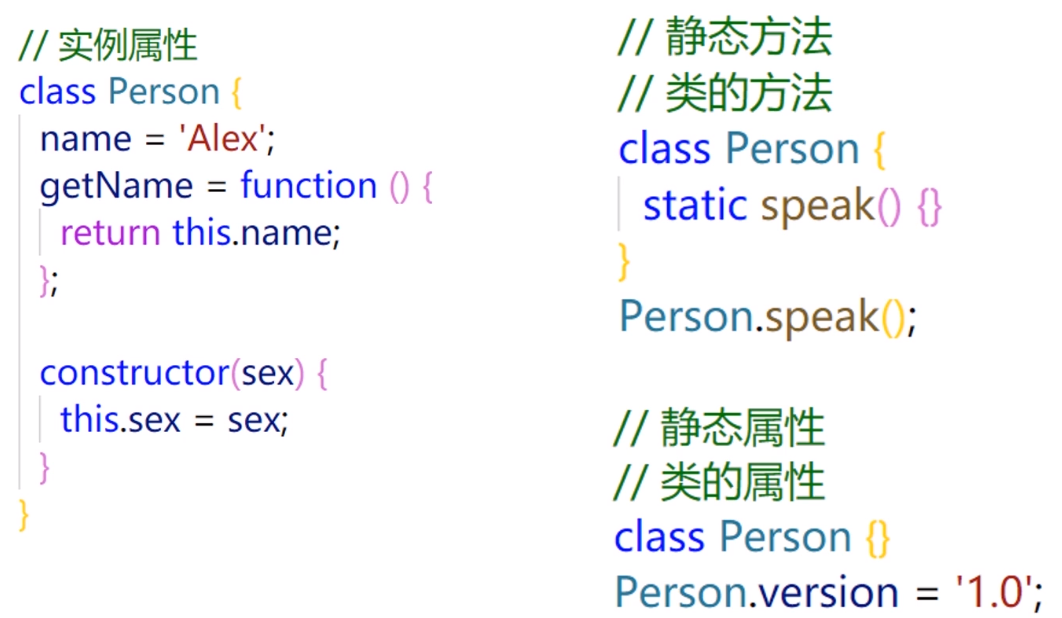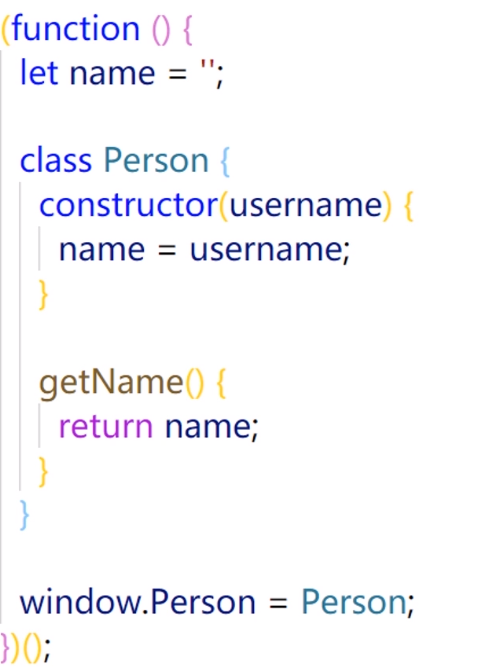课程简介
学什么
初识Class
Class的属性和方法
Class的继承
Class的应用
初识 Class
Class是什么
Class的两种定义形式
Class的属性和方法
实例属性、静态方法和静态属性
私有属性和方法
Class的继承
extends
super
Class的应用
幻灯片
1.初识class
- 认识Class
- Class的基本用法
- Class 与构造函数
1.Class是什么
1.认识 Class
人类:类
具体的人:实例、对象
类可以看做是对象的模板,用一个类可以创建出许多不同的对象
2.Class 的基本用法
类名一般大写 不需要圆括号和分号
js
class Person {} √
class Person() {} ×
class Person {}; ×
js
class Person {
// 实例化时执行构造方法,所以必须有构造方法
constructor(name, age) {
console.log('实例化时执行构造方法');
//this 代表实例对象,上面定义的是实例属性/方法
this.name = name;
this.age = age;
// 一般在构造方法中定义属性,方法不在构造方法中定义
//this.speak = () => {};
}
//speak:function(){}
speak() {
console.log('speak');
}
}
const zs = new Person('ZS', 18);
const ls = new Person('LS', 28);
console.log(zs.name);
console.log(zs.age);
console.log(zs.speak;
console.log(ls.name);
console.log(ls.age);
console.log(ls.speak);
zs.speak();
console.log(zs.speak === ls.speak); //false
3.Class 与构造函数
js
//Class
class Person {
constructor(name, age) {
this.name = name;
this.age = age;
}
speak() {
console.log('speak');
}
}
console.log(typeof Person);
console.log(Person.prototype.speak); //本质上是函数并且方法是绑定在原型之上
//构造函数
function Person(name, age) {
this.name = name;
this.age = age;
//不在这里声明
//this.speak = () => {};
}
Person.prototype.speak = function () {};
2.Class的两种定义形式
声明形式
表达式形式
1.声明形式
js
class Person {
constructor() {}
speak() {}
}
2.表达式形式
js
function Person(){}
const Person = function () {};
//构造函数声明与表达式的形式
//匿名的类赋值给常量
const Person = class {
constructor() {
console.log('constructor');
}
speak() {}
}
new Person();
//立即执行函数
(function () {
console.log('fn');
})();
new (class {
constructor() {
console.log('constructor');
}
})();
2.属性与方法
1.实例属性和方法
js
class Person {
age = 0;
sex = 'male';
//方法就是值为函数的特殊属性
getSex = function () {
return this.sex;
};
constructor(name, sex) {
this.name = name;
//如果用户没有传递sex值,那么就是用默认值的
//实例化时传入的值,那么就使用传入的值
//实例化时没有传入值,那么就使用默认的值
this.sex = sex || this.age;
}
//实例方法
speak() {
console.log("speak")
}
}
const p = new Person('"yunmu"',"male");
console.log(p.name);
console.log(p.age);
2.静态方法
类的方法
js
class Person {
age = 0;
sex = 'male';
constructor(name, sex) {
this.name = name;
this.sex = sex;
}
speak() {
this.age = 18;
console.log(this); //指向对象
}
//静态方法 建议这一种
static speak() {
console.log('人类可以说话');
console.log(this); // this 指向类
}
}
//静态方法 第二种定义
Person.speak = function () {
console.log('人类可以说话');
console.log(this);
};
const p = new Person('Alex');
p.speak();
Person.speak(); //不会冲突
3.静态属性
类的属性
js
class Person {
constructor(name) {
this.name = name;
}
// 不要这么写,目前只是提案,有兼容性问题
// static version = '1.0';
static getVersion() {
return '1.0';
}
}
// Person.version = '1.0';
const p = new Person('Alex');
console.log(p.name);
// console.log(Person.version);
console.log(Person.getVersion());
4.私有属性和方法
1.为什么需要私有属性和方法
一般情况下,类的属性和方法都是公开的
公有的属性和方法可以被外界修改,造成意想不到的错误
js
class Person {
constructor(name) {
this.name = name;
}
speak() {
console.log('speak');
}
//通过方法去获取name 不通过属性
getName() {
return this.name;
}
}
const p = new Person('yunmu');
console.log(p.name);
p.speak();
// ....
// p.name = 'zs';
// console.log(p.name);
2.模拟私有属性和方法
1.开头表示私有
js
class Person {
constructor(name) {
this._name = name;
}
speak() {
console.log('speak');
}
getName() {
return this._name;
}
}
const p = new Person('yunmu');
// console.log(p._name);
p.name = 'zd';
console.log(p.getName());
2.将私有属性和方法移出类
js
(function () {
let name = '';
class Person {
constructor(username) {
// this.name = name;
name = username;
}
speak() {
console.log('speak');
}
getName() {
return name;
}
}
window.Person = Person;
})();
(function () {
const p = new Person('yunmu');
console.log(p.name);
//只能通过这样访问
console.log(p.getName());
})();
3.继承
extends
- 子类继承父类
- 改写继承的属性或方法
1.子类继承父类
js
//父类
class People {
constructor(name) {
this.name = name;
}
eat(){
console.log(`${this.name} eat something`);
}
static speak(){
console.log(`人类的本质都是复读机`);
}
}
//子类
class Student extends People{
constructor(name, number) {
super(name);
//this.name = name;
this.number = number;
//this.gender = "female";
}
sayHi() {
console.log(`姓名${this.name} 学号${this.number}`);
}
}
//子类
class Teacher extends People{
constructor(name,major){
super(name);
this.major = major;
}
teach(){
console.log(`${this.name} 教授 ${this.major}`);
}
}
//学生实例
const liyujiao = new Student("李玉俏", 100);
console.log(liyujiao);
console.log(liyujiao.name);
console.log(liyujiao.number);
liyujiao.sayHi();
//学生实例
//const lindaiyu = new Student("林黛玉", 101);
//console.log(lindaiyu);
//console.log(lindaiyu.name);
//console.log(lindaiyu.number);
//lindaiyu.sayHi();
//老师实例
const jiayucun = new Teacher("贾雨村", "诗词格律");
console.log(jiayucun);
console.log(jiayucun.name);
console.log(jiayucun.major);
jiayucun.teach();
jiayucun.eat();
2.改写继承的属性或方法
js
//父类
class People {
constructor(name) {
this.name = name;
}
eat(){
console.log(`${this.name} eat something`);
}
static speak(){
console.log(`人类的本质都是复读机`);
}
}
//子类
class Student extends People{
constructor(name, number) {
super(name);
//this.name = name;
this.number = number;
//this.gender = "female";
}
sayHi() {
console.log(`姓名${this.name} 学号${this.number}`);
}
}
//子类
class Teacher extends People{
constructor(name,major){
super(name);
//this 操作不能放在 super 前面
this.major = major;
}
teach(){
console.log(`${this.name} 教授 ${this.major}`);
}
//同名覆盖
eat(){
console.log(`${this.name} 在吃饭`);
}
//同名覆盖
static speak(){
console.log("学者必求师 为师不可不谨也");
}
}
//学生实例
const liyujiao = new Student("李玉俏", 100);
console.log(liyujiao);
console.log(liyujiao.name);
console.log(liyujiao.number);
liyujiao.sayHi();
//学生实例
//const lindaiyu = new Student("林黛玉", 101);
//console.log(lindaiyu);
//console.log(lindaiyu.name);
//console.log(lindaiyu.number);
//lindaiyu.sayHi();
//老师实例
const jiayucun = new Teacher("贾雨村", "诗词格律");
console.log(jiayucun);
console.log(jiayucun.name);
console.log(jiayucun.major);
jiayucun.teach();
jiayucun.eat();
Teacher.speak()
super
- 作为函数调用
- 作为对象使用
- 注意事项
1.作为函数调用
代表父类的构造方法,只能用在子类的构造方法中,用在其他地方就会报错
super 虽然代表了父类的构造方法,但是内部的 this 指向子类的实例
js
//父类
class People {
constructor(name) {
console.log(this);
this.name = name;
}
eat() {
console.log(`${this.name} eat something`);
}
static speak() {
console.log(`人类的本质都是复读机`);
}
}
//子类
class Student extends People {
constructor(name, number) {
super(name);
this.number = number;
}
sayHi() {
//super(); // ×
console.log(`姓名${this.name} 学号${this.number}`);
}
}
//学生实例
const liyujiao = new Student("李玉俏", 100);
console.log(liyujiao.name);
console.log(liyujiao.number);
liyujiao.sayHi();
2.作为对象使用
js
//父类
class People {
constructor(name) {
this.name = name;
}
eat() {
console.log(this);
console.log(`${this.name} eat something`);
}
static speak() {
console.log(this);
console.log(`人类的本质都是复读机`);
}
}
/*
1.在构造方法中使用或一般方法中使用
super 代表父类的原型对象 Person.prototype
所以定义在父类实例上的方法或属性,是无法通过 super 调用的
通过 super 调用父类的方法时,方法内部的 this 指向当前的子类实例
*/
//子类
class Student extends People {
constructor(name, number) {
super(name);
this.number = number;
//作为对象在构造方法中调用
//super.eat();
}
sayHi() {
console.log(`姓名${this.name} 学号${this.number}`);
}
eat() {
//作为对象在一般方法中调用
super.eat();
console.log("吃大口");
}
//2.在静态方法中使用
//指向父类,而不是父类的原型对象
//通过 super 调用父类的方法时,方法内部的 this 指向当前的子类,而不是子类的实例
static speak(){
super.speak();
console.log(`我是${this.name} 我正在学习!`);
}
}
//学生实例
const liyujiao = new Student("李玉俏", 100);
console.log(liyujiao.name);
console.log(liyujiao.number);
liyujiao.sayHi();
liyujiao.eat();
Student.speak();
3.注意事项
使用 super 的时候,必须显式指定是作为函数还是作为对象使用,否则会报错
js
//父类
class People {
constructor(name) {
this.name = name;
}
eat() {
console.log(this);
console.log(`${this.name} eat something`);
}
static speak() {
console.log(this);
console.log(`人类的本质都是复读机`);
}
}
//子类
class Student extends People {
constructor(name, number) {
super(name);
this.number = number;
//console.log(super); // ×
//console.log(super());
//console.log(super.speak);
}
}
4.Class的应用
html
<!DOCTYPE html>
<html lang="en">
<head>
<meta charset="UTF-8" />
<title>Class 的应用</title>
<style>
/* css reset */
* {
padding: 0;
margin: 0;
}
a {
text-decoration: none;
outline: none;
}
img {
vertical-align: top;
}
/* layout */
.slider-layout {
width: 80%;
height: 420px;
margin: 100px auto;
}
/* slider */
.slider,
.slider-content,
.slider-item,
.slider-img {
width: 100%;
height: 100%;
}
.slider {
overflow: hidden;
}
.slider-item {
float: left;
}
.slider-animation {
transition-property: transform;
transition-duration: 0ms;
}
</style>
</head>
<body>
<div class="slider-layout">
<div class="slider">
<div class="slider-content">
<div class="slider-item">
<a href="javascript:;"
><img src="./imgs/1.jpg" alt="1" class="slider-img"
/></a>
</div>
<div class="slider-item">
<a href="javascript:;"
><img src="./imgs/2.jpg" alt="1" class="slider-img"
/></a>
</div>
<div class="slider-item">
<a href="javascript:;"
><img src="./imgs/3.jpg" alt="1" class="slider-img"
/></a>
</div>
<div class="slider-item">
<a href="javascript:;"
><img src="./imgs/4.jpg" alt="1" class="slider-img"
/></a>
</div>
</div>
</div>
</div>
<script>
// 默认参数
const DEFAULTS = {
// 初始索引
initialIndex: 0,
// 切换时是否有动画
animation: true,
// 切换速度,单位 ms
speed: 300
};
// base
const ELEMENT_NODE = 1;
const SLIDER_ANIMATION_CLASSNAME = 'slider-animation';
class BaseSlider {
constructor(el, options) {
console.log(options)
if (el.nodeType !== ELEMENT_NODE)
throw new Error('实例化的时候,请传入 DOM 元素!');
// 实际参数
this.options = {
...DEFAULTS,
...options
};
const slider = el;
const sliderContent = slider.querySelector('.slider-content');
const sliderItems = sliderContent.querySelectorAll('.slider-item');
// 添加到 this 上,为了在方法中使用
this.slider = slider;
this.sliderContent = sliderContent;
this.sliderItems = sliderItems;
this.minIndex = 0;
this.maxIndex = sliderItems.length - 1;
this.currIndex = this.getCorrectedIndex(this.options.initialIndex);
// 每个 slider-item 的宽度(每次移动的距离)
this.itemWidth = sliderItems[0].offsetWidth;
this.init();
}
// 获取修正后的索引值
// 随心所欲,不逾矩
getCorrectedIndex(index) {
if (index < this.minIndex) return this.maxIndex;
if (index > this.maxIndex) return this.minIndex;
return index;
}
// 初始化
init() {
// 为每个 slider-item 设置宽度
this.setItemsWidth();
// 为 slider-content 设置宽度
this.setContentWidth();
// 切换到初始索引 initialIndex
this.move(this.getDistance());
// 开启动画
if (this.options.animation) {
this.openAnimation();
}
}
// 为每个 slider-item 设置宽度
setItemsWidth() {
for (const item of this.sliderItems) {
item.style.width = `${this.itemWidth}px`;
}
}
// 为 slider-content 设置宽度
setContentWidth() {
this.sliderContent.style.width = `${
this.itemWidth * this.sliderItems.length
}px`;
}
// 不带动画的移动
move(distance) {
this.sliderContent.style.transform = `translate3d(${distance}px, 0px, 0px)`;
}
// 带动画的移动
moveWithAnimation(distance) {
this.setAnimationSpeed(this.options.speed);
this.move(distance);
}
// 设置切换动画速度
setAnimationSpeed(speed) {
this.sliderContent.style.transitionDuration = `${speed}ms`;
}
// 获取要移动的距离
getDistance(index = this.currIndex) {
return -this.itemWidth * index;
}
// 开启动画
openAnimation() {
this.sliderContent.classList.add(SLIDER_ANIMATION_CLASSNAME);
}
// 关闭动画
closeAnimation() {
this.setAnimationSpeed(0);
}
// 切换到 index 索引对应的幻灯片
to(index) {
index = this.getCorrectedIndex(index);
if (this.currIndex === index) return;
this.currIndex = index;
const distance = this.getDistance();
if (this.options.animation) {
return this.moveWithAnimation(distance);
} else {
return this.move(distance);
}
}
// 切换上一张
prev() {
this.to(this.currIndex - 1);
}
// 切换下一张
next() {
this.to(this.currIndex + 1);
}
// 获取当前索引
getCurrIndex() {
return this.currIndex;
}
}
</script>
<script>
// console.log(BaseSlider);
class Slider extends BaseSlider {
constructor(el, options) {
super(el, options);
this._bindEvent();
}
_bindEvent() {
document.addEventListener('keyup', ev => {
// console.log(ev.keyCode);
if (ev.keyCode === 37) {
// ←
this.prev();
} else if (ev.keyCode === 39) {
// →
this.next();
}
});
}
}
new Slider(document.querySelector('.slider'), {
initialIndex: 1,
animation: true,
speed: 1000
});
</script>
</body>
</html>
课程总结
Class的基本用法
Class的两种定义形式
声明形式
表达式形式
实例属性、静态方法和静态属性
私有属性和方法
_开头表示私有
将私有属性和方法移出类
extends
使用extends可以实现继承
可以改写继承到的属性或方法,同名覆盖
super
作为函数调用
作为对象使用
使用super的时候,必须显式指定作为函数还是作为对象使用
super作为函数调用
super代表父类的构造方法,只能用在子类的构造方法中
内部的this指向子类的实例
super作为对象使用
在构造方法和一般方法中使用
super代表父类的原型对象
通过super调用父类的方法时,方法的this指向当前的子类实例
在静态方法中使用
super代表父类
通过super调用父类的方法时,方法的this指向当前的子类
 tian~
tian~









